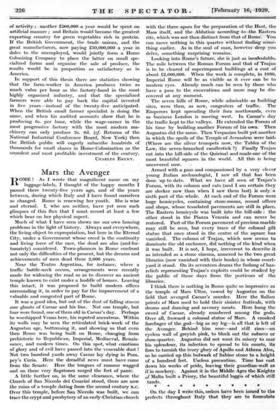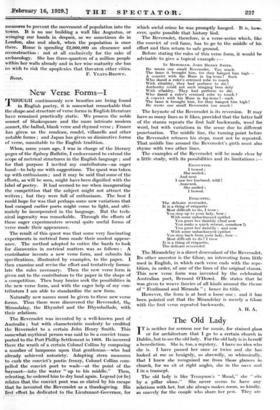Mars the Avenger
ROMEROME ! As I wrote that magnificent name on my I thought of the happy months I passed there twenty-five years ago, and of the years between, during which -Italy and I -have found ourselves so changed. Rome is renewing her youth. She is wise and eternal. I, who am neither, have yet seen such glimpses of this flux that I must- record at least a few which bear on her physical aspect. Much of what I have seen shows- me our own housing problems in the light of history. Always and everywhere, the living object to expropriation,-but here in the Eternal City, under a Government whose creed is the continuity and living force of the race, the dead are also (and for- tunately) considered. Town-planners in Rome confront not only.the difficulties-of the present, but the dreams and achievements of men dead these 2,000 years. Near the Teatro Argentina, for instance, where a traffic • bottle-neck occurs, arrangements were recently made- for -widening the road so as to discover an ancient temple known to exist under a huddle of houses. Leaving this intact; it- was proposed to build modem offices surrounding it, in order to pay for the improvement of a valuable and- congested part of Rome. - It was a good idea, but out of the dust of falling stucco rose ghosts of Caesar- and his line. Not one temple, but four were found, one of them old in Caesar's day. Perhaps he worshipped Venus here, his reputed ancestress. Within its walls may be seen the reticulated brick-work of the Augustan age, buttressing it, and showing us that even then Rome was being built on Rome, changing from prehistoric to Republican, Imperial, Mediaeval, Renais- sance, and modern times. On this spot, what emotions of glory and of evil have passed into the venerable dust ! Not two hundred yards away Caesar lay dying in Porn.. pey's Curia. Here the dreadful news must have come from the Senate. Here the tongues of rumour wagged and on these very flagstones surged the feet of panic. A little -further on, in the same clearance, where the Church of San Niccolo dei Cesarini stood, there are now the ruins of a temple dating from the second century B.c. Over this temple, before San Niccolo was built, we can trace the crypt and presbytery of an early-Christian church with the three apses for the preparation of: the Host, the Mass itself, and the Ablution according to the Eastern 'rite, which was not then distinct from that of Rothe. You can move nothing in this quarter without -finding' some- thing earlier. As in the soul of man, howeVer deep you delve; something surprising remains. Looking into Roniers future, she is just as incalculable. The mile between the Roman Forum and that of Trajan is to be cleared of superimposed buildings at a cost of about £2,000,000. When the work is complete, in 1930, Imperial Rome will be as visible as it ever can be to modern eyes. Already much can be seen by those who have a pass to the excavations and more may be dis- covered at any moment. The seven bills of Rome, while admirable as building sites, were then, as now, congesters of traffic. The Emperors kept spreading their fora northwards, even as business London is moving west. In Caesar's day the traffic kept to the valleys. He extended-the Forum of his time by building another Forum of his own. Then Augustus did the same. Then Vespasian built yet another in which the spoils of the Temple of Jerusalem were laid: (Where are the silver trumpets now, the Tables of the Law, the seven-branched candlestick ?) Finally Trajan cut into the hill-side of the Quirinal.and.made one of the most beautiful squares in the world. All this is being uncovered now. - - Armed with a pass and companioned by a very clever young Italian archaeologist, I saw all that has been done -up to date. What we have all seen of Trajan's Forum, with its column and cats (and I am certain they are sleeker now than when I saw them last) is only a sixth part of the whole. At each end of the Forum were huge hemicycles, containing store-rooms, record offices and shops, whose tesselated pavements are still in place. The Eastern hemicycle was built into- the -hill-side : the other stood in the Piazza Venezia and can never be restored. Part of the Forum pavement of precious marble may still be seen, but every trace of the colossal gilt statue that once stood in the centre of the square has vanished. The column of Trajan, which now seems to dominate the old enclosure, did nothing of the kind when it was built. It is not, I hope, irreverent to describe it as intended as a stone cinema, annexed to the two great libraries (now vanished with their books) in whose court- yard it stood. On its seventeen drums the furlong of bas- reliefs representing Traj an's exploits could be studied by the public of those days from the porticoes of the libraries: I think there is nothing in Rome, quite so impressive as the temple of Mars Ultor, vowed by Augustus on the field that avenged Caesar's murder. Here the Salian priests of Mars used to hold their sinister festivals, with drums and dancing and savoury meats. Here hung the sword of Caesar, already numbered among the gods: Over all, frowned a colossal statue of Mars. A crooked forefinger of the god—big as my leg—is all that is left of the Avenger. Behind him rose—and still rises—an eyeless wall of greyish pink, to block out the suburra or slum-quarter. Augustus did not want its misery to, mar his splendour, its infection to spread to his courts, its fires to tarnish the ivory glory of Apollo and Athena Ales, so he carried up this bulwark of Sabine stone to a height of a hundred feet. Useless precaution. Time has cast down his works of pride, leaving their guardian-wall as if in mockery. Against it in the Middle. Ages the Knights of Malta built a Priory, the beautiful loggia of which still t,ands. - * * * * * * * * On the day I Write this, orders have been issued to the prefects throughout Italy that they are to formulate measures to prevent the movement of population into the towns. It is no use building a wall like Augustus, or wringing our hands in despair, as we sometimes do in London, alas and alack, when the population is once there. Rome is spending £2,000,000 on clearance and reconstruction : not at all exclusively for the sake of archaeology. She has three-quarters of a million people within her walls already and in her wise maturity she has no wish to risk the apoplexies that threaten other cities. F. YVATS-BROWN. Rome.











































 Previous page
Previous page